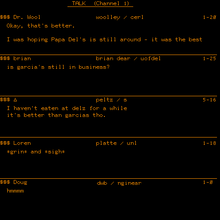Talkomatic
This article needs additional citations for verification. (April 2024) |
| Original author(s) | Doug Brown David R. Woolley |
|---|---|
| Initial release | 1973 |
| Platform | PLATO |
| Type | Online chat system |
| Website | https://open.talkomatic.co/ |

Talkomatic is an online chat system[1] that facilitates real-time text communication among a small group of people. Each participant in Talkomatic has their own section of the screen, broadcasting messages letter-by-letter as they are typed. This interaction was dissimilar from present-day chat systems and was based upon work done in 1973 at the University of Illinois on the PLATO system by Doug Brown and David R. Woolley.
History
[edit]The original Talkomatic was the first multi-user online chat system, with the possible exception of the Party Line function of the Emergency Management Information Systems And Reference Index (EMISARI) system, created for the US Office of Emergency Preparedness by Murray Turoff in 1971.[2][3] Talkomatic was created by Doug Brown and David R. Woolley in 1973 on the PLATO System[4] at the University of Illinois. It offered six channels (the analog of a "room"), which could each hold up to five participants.[5] Along with PLATO Notes and a wide variety of games, Talkomatic was one of the features of PLATO that gave rise to a large online community that persisted into the mid 1980s.
Ray Ozzie's smartphone app, Talko (launched in September 2014 and acquired, and dissolved by Microsoft in 2016), was named after Talkomatic, which Ozzie experienced while working on the PLATO System in the 1970s.
Web version
[edit]On March 11, 2014, Brown and Woolley released a new version of Talkomatic designed for the web. Intended to be a reinterpretation of its 1970s namesake, it is conceptually similar to the original system, but limitations imposed by the resource constraints of the time (such as the maximum room count) have been lifted. However, as of March 14, 2024, the web is now unavailable for public use due to technical reasons and the action of some users that were considered disrespectful.[6] But, as of June 2024, Talkomatic is back up and bans people who do disrespectful actions.
Revival of original concepts
[edit]Features of the original work included public, private and semi-private spaces which enabled five concurrent "chatters" to communicate in accordance with their privacy needs.
By the end of 2017, Talkomatic was in its third version and supported the original's features of Public and Private rooms but work on the final feature, Semi-Private rooms had not been implemented.
On March 11, 2018, Version 4 was released, completing the features of the original version with some enhancements in support of the greater variety of modern-day browsers and display resolutions. With this final addition, a feature was added to address the problems arising from truly anonymous access.
On March 4, 2024, a well-known YouTuber under the online alias of yikes attempted to revive a reimagined version of the website Talkomatic by advertising it on TikTok, Reddit, YouTube and Instagram.[7] However, this effort led to the website's shutdown due to the server's inability to handle the increased load.[8] As of June 2024, Talkomatic is back up and running on talkomatic.co because of the community.[9]
Enabling anonymity
[edit]The original Talkomatic evolved in the PLATO community which was largely limited by the constraints of requiring credentials used to access the PLATO system. The system recognized different types of users: authors, instructors, students and multiples. These users were managed as "groups" and the owners of those groups provided the administrative oversight necessary if user conduct was deemed inappropriate by others. At the discretion of a group owner, credentials could be suspended or revoked entirely. The most anonymous of the credential types, multiples, could be prevented from accessing the Talkomatic system, thus preventing any type of anonymous access.
Talkomatic (Web version) was designed to be freely available for use by anyone but complete anonymity invited abuse. The Version 4 solution was to implement an in-room voting system for rooms holding three or more participants. Participants who deemed the conduct of another to be inappropriate could "vote-down" the offending user. If a participant's conduct is deemed inappropriate by more than half of the participants, the offending participant is ejected from the room.
In addition to Brown and Woolley's original domain (talko.cc), Ray Ozzie donated three other domains to the conservation efforts. In 2018, Talkomatic was available at talko.cc, talkomatic.com, talkomatic.org, and talkomatic.net.
References
[edit]- ^ Falk, Joni K.; Drayton, Brian (25 April 2015). Creating and Sustaining Online Professional Learning Communities. Teachers College Press. pp. 8–. ISBN 9780807772140. Archived from the original on 22 January 2023. Retrieved 30 May 2014.
- ^ IRC History -- EMISARI, archived from the original on 2014-10-02, retrieved 2014-09-28
- ^ Hiltz, Roxanne (1993). The Network Nation: Human Communication via Computer. MIT Press. ISBN 0262581205.
- ^ Bidgoli, Hossein (2004). The Internet Encyclopedia. John Wiley & Sons. pp. 665–. ISBN 9780471222040. Retrieved 30 May 2014.
- ^ PC Mag. Ziff Davis, Inc. 17 April 1984. pp. 221–. Archived from the original on 22 January 2023. Retrieved 30 May 2014.
- ^ "Talkomatic: Unavailable". Talkomatic. Archived from the original on 2024-03-15. Retrieved 2024-03-19.
- ^ yikes (2024-03-04). I Revived the Oldest Social Media. Retrieved 2024-11-20 – via YouTube.
- ^ xander (2024-06-06). I killed the oldest social media. Retrieved 2025-01-14 – via YouTube.
- ^ Talkomatic. "Talkomatic 2024 - Create and Join Chat Rooms". www.talkomatic.co. Retrieved 2024-07-05.
- Woolley, David R (January 1994). "PLATO: The Emergence of Online Community". Matrix News. Retrieved May 30, 2014.
- Encyclopedia of New Media. Sage Publications. 2003.
